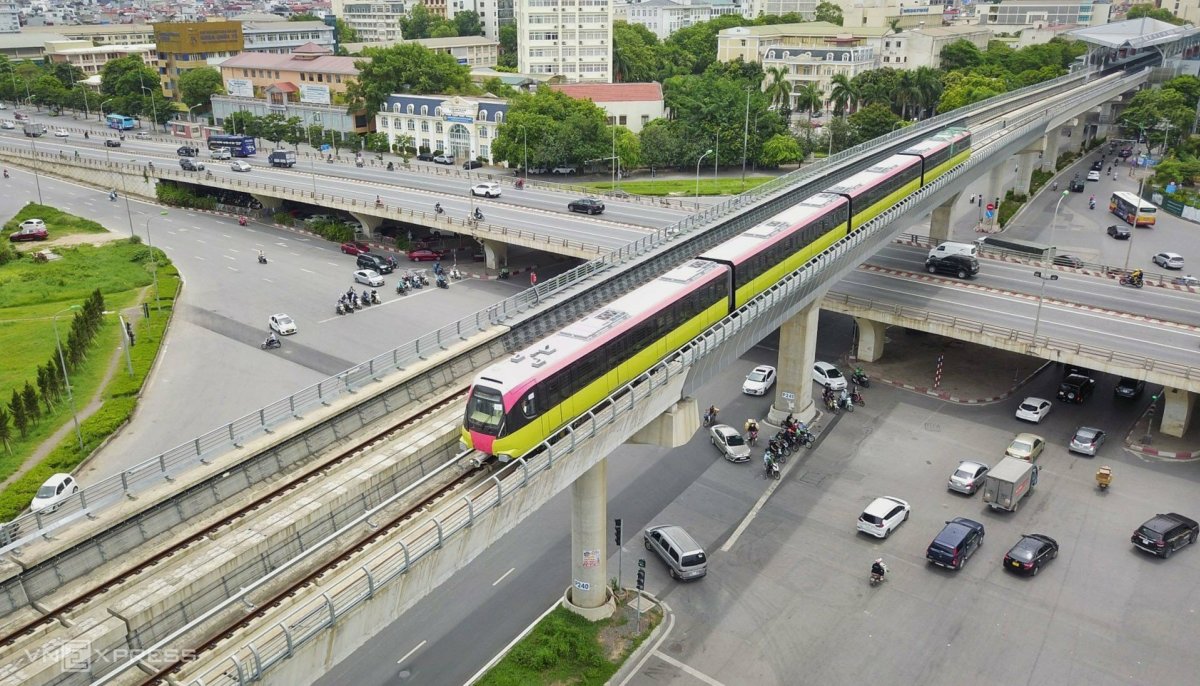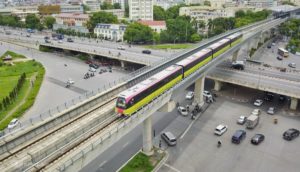 Never-ending construction of Hanoi’s metro irks the city
Never-ending construction of Hanoi’s metro irks the city
The Nhon-Hanoi Station metro line, meant to be a beacon for traffic connectivity and economic development, has been delayed seven times over the last 17 years.
For the last two decades, the 12.5 km-long ongoing construction site has been a headache for those living nearby and local commuters alike. Not to mention it’s a messy eyesore for anyone in the city who happens to catch a glimpse from a tall building or pass by on an adjacent road.
While she was on her way home from the market one morning, Hoang Thi Binh, 69, heard a loud thump in front of her home on Tran Hung Dao Street in central Hanoi’s Hoan Kiem District. About 5 m from the house, a woman was struggling to ride her motorbike on a road full of potholes, next to the construction site of an underground station for the Nhon-Hanoi Station metro line.
The woman eventually lost control of her vehicle, and the motorbike rammed into an electric pole on the side of the road. Binh called her neighbors and an ambulance for help. But the emergency vehicle couldn’t make it through the potholes either, so the woman had to be carried for hundreds of meters before they could get her to the main street.
“It’s like clockwork,” said Binh in reference to the regular accidents around her 1.2-m-wide alley near the site. “A few months ago, someone even broke their legs.”
Binh said she has now learned to reflexively lean herself onto the alley walls anytime a motorbike comes near.
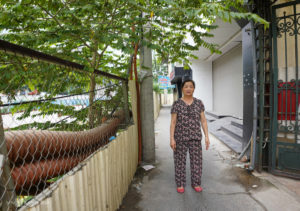
The alley in front of Binh’s house is a part of Tran Hung Dao Street, where several hospitals, banks, hotels, and state institutions are located. At one end of the street next to the Hanoi Train Station will be the final underground station of the Nhon-Hanoi Station metro line.
The metro line, spanning 12.5 km with eight elevated and four underground stations, is part of an urban railway line spanning 20 km connecting western areas with downtown Hanoi and the city’s southern areas in Hoang Mai District. The project is expected to boost public transport in the west and move the population and traffic away from downtown areas, where population density can be dozens of times higher than that of the suburbs.
In 2006, the project was approved with a total investment capital of over €783 million (US$840.4 million), and was initially planned to be completed in 2010. But not until 2010 did construction actually begin. The government at the time requested Hanoi and the Metropolitan Railway Management Board (MRB) to keep things on schedule, so that the metro line could open in 2015.
And now, by 2023, 17 years after approval and 13 years after construction began, the project remains unfinished.
The project is now 76.5% completed, according to an MRB report. The elevated section from Nhon to Kim Ma is 99% completed, and its commercial operation date has been delayed four times and is now slated for the end of this year. The underground section from Kim Ma to the Hanoi Station is only 33% completed, and its managers and investors are even at risk of being sued for slow land clearance.

In May, the government agreed to extend the metro’s completion deadline to 2027, ballooning its investment from VND18 trillion ($748.1 million) to VND34.8 trillion. If this plan holds close to true, it will eventually have taken 21 years to build the relatively short route.
The decade-long wait
The years after construction first began, barriers around the digging site of the last underground station were erected in front of Binh’s house.
It was a day in June 2019.
“Just a little while more, and the value of your property would turn from gold to diamond,” Binh recalled what a manager of the construction site at the time told her. She began to get her hopes up that her 230-m2 land plot would indeed become a “gem” on this Hanoi street. According to her research, real estate prices were expected to increase by at least 1.5 times compared to other areas once the metro line begins operation.
But that day never came.
Just a few months after the barriers were erected, for the first time ever, Binh reduced the rent price for her land to 80% of what it used to be. A year after that, she reduced the figure to 70%, then 50%. She was willing to earn less rather than let her tenants leave. But none of them stayed anyway.

The barriers, spanning 217 m from Tran Hung Dao to Quan Su, has relegated a property facing a large street into one that has become a tiny, enclosed alley. The neighborhood bank left first, followed by the insurance company, and then the barber’s shop. Binh had lost her income worth hundreds of millions of dong a month, despite living in one of the most coveted locations of the city.
Along the 4 km underground station from Kim Ma to Tran Hung Dao, authorities said at least 50 buildings have been affected by the construction process. Some 230 families have been directly blocked from access to major city roads by the barriers, not to mention houses that were indirectly damaged by the construction. Some 117 families have sent frequent complaints to the Asia Development Bank, which sponsors the project, for compensation. Any funds that have been paid out so far has been described as “inadequate.”
Kim Ma Street went from being one of the busiest roads of the capital, with land plots spanning 50-60 m2 capable of netting VND50 million a month, to a road where certain sections are now considered virtually “dead”. Families have sold their houses and shops have begun to switch to other businesses, all waiting for the day when the barriers will finally be removed.
The delayed construction of the project has done more than economic damage.

Do Thuy Linh said the 6 km of road from Nguyen Khanh Toan to Tran Hung Dao is “torture,” considering how she has to travel through the Lieu Giai-Dao Tan intersection twice a day. In 2022, the area was named among the 32 most congested traffic points in Hanoi due to the barriers erected for the construction of the S9 underground metro station.
At 8 a.m. every morning, Linh has to spend time on the road moving meter by meter through the crowded traffic. The heat of the exhaust fumes, along with the deafening sirens, makes the trip far from enjoyable.
With a railway spanning 1.435 m in width and an average train speed at 37 kph, traveling throughout the entire metro line should take around 20 minutes, while a motorbike should take around 45 minutes to travel the same distance in the city. But as the metro has not been completed, every day Linh has to spend 90 minutes traveling 12 km back and forth in the city. That figure can rise to three hours if it rains or if it is rush hour: the same time it takes to travel 150 km from Hanoi to the north-central province of Thanh Hoa.
The ongoing construction of the metro has created several traffic congestion points. In 2014, several such points sprung into being after construction of the Nhon-Hanoi Station and the Cat Linh-Ha Dong metro lines began, the latter opened to traffic in late 2021 also after 10-year construction and several delays.
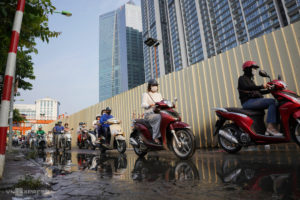
Traffic in western Hanoi now relies mostly on National Highway 32, which is overloaded. Moving the population away from downtown areas is not possible, considering how a suburban district like Hoang Mai has seen its population nearly double after 15 years. The capital’s public transport capability, mostly using buses, has only reached 17% of transport demand, instead of 35% as planned.
“There was a time when we students would tell each other to travel from Cau Giay to the Hoan Kiem Lake area to eat ice cream and check-in, once the elevated railway is completed,” Linh recalled her memories from 15 years ago.
The people of Hanoi have been waiting for a day when they can watch the city from the windows of the metro trains off the ground, instead of navigating within the crowded traffic below. But for Linh, her real-life visions of the Nhon-Hanoi Station metro line only include traffic jams, and a crane accident.
It was May 12, 2015. A crane weighing thousands of tons working on the metro construction site fell down on top of two houses of Cau Giay Street. A cable lashed a pregnant woman who was on her way home from work. She fortunately escaped with her life intact, telling herself that she was “lucky”.
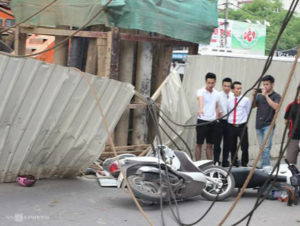
Two days prior to the incident, a steel beam spanning dozens of meters and weighing 600 kg also slipped off a crane and fell onto Ho Tung Mau Street in Bac Tu Liem District. That beam fell right in front of two men who were riding motorbikes, but fortunately reacted in time to avoid it. Some 10% out of the 2,000 beams were eventually evaluated and removed due to being severely degraded.
Besides the Nhon-Hanoi Staton metro line, all other ongoing urban metro projects in Hanoi and HCMC are falling behind schedule, incurring a cost of VND84 trillion, according to a governmental report sent to the National Assembly in October 2021. Hanoi in particular has spent two decades arguing about cutting trees down for the metro.
Dao Dinh Tung, a senior who used to sell lottery tickets under a row of African mahoganies on Kim Ma Street, often wonders why it has taken so long for the metro line to be completed.
When the trees were still there, people would often see Tung as they passed by Kim Ma Street. In 2016, when the row of trees were relocated to build the S9 station, Tung also moved his booth away, looking for any tree he could find. When the 107th tree was relocated, Tung decided to call it quits.
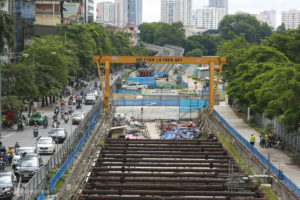
He often wishes for another row of trees like the one he used to have back in those days. Meanwhile, the metro remains incomplete.
Why the delay?
Le Trung Hieu, deputy head of the Hanoi Metropolitan Railway Management Board, said the delayed progress is due to two main reasons: land clearance issues and the limited capabilities of depot contractors.
Hieu said it took four years to deal with a structure violating railway safety corridor near the S7 station, and up to six years to clear the land for one underground metro construction. The depot, built by the Hanoi Construction Corporation (Hancop), is the only bidding package of the entire line that has been five years behind schedule.
All the delays in construction and land clearance may cost Hanoi VND6 trillion ($249 million) in fines. In 2020, the South Korean contractor building the elevated section demanded compensation of $19 million because the land for the construction was handed over to them 1.5 years later than planned. Over the next two years, the Hyundai-Ghella joint contractors stopped construction of underground stations twice and demanded at least $115 million again for the same reason.
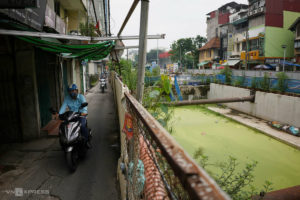
“We already tried our best,” Hieu said.
Phan Le Binh, a traffic expert, said the delays stemmed from three factors. First, all the metro projects are major ones that cost billions of dollars. Taking dozens of years, or even more, for such projects to be completed, is therefore “normal.”
Second, large-scale infrastructure within the city is bound to see obstacles and challenges spring up. The Nhon-Hanoi Station metro line is far from the only one with problems: most urban metro projects are in the same situation. The most difficult part is land clearance, as houses aside, there is a lot of infrastructure running along the path of the metro, including electrical, water and telecommunication systems.
“The most complicated conflicts arise once construction of the underground station begins,” Binh said, adding that underground infrastructures require robots to dig into the ground. For the Nhon-Hanoi Station metro line, there are two such sites: one on Kim Ma and the other on Ngo Si Lien Street. These sites are very large, and need to be open so the robots can get in. But existing underground infrastructures (pipes, cables, etc) represent a challenge: there were too many that needed to be relocated or converted, extending the time needed for construction by several months.
“Initial surveys do not see all of the underground infrastructures. Vietnam also does not have a database on underground infrastructures,” Binh said, adding that sometimes units in charge of the underground pipes, wires and cables are not even sure how many underground infrastructures there are, and negotiations with the units who manage such systems are often more time-consuming than expected.
Third is the complexity when dealing with the natural soil foundation, construction sites can span dozens of kilometers, unlike the construction of normal civilian structures. Contractors can only perform geological surveys by drilling in certain locations, then using speculations with mathematical models to figure out the area’s geological characteristics. But in reality, the actual construction would be very different. The shifting soil means that the design must be changed as well.
The change in design would lead to an adjustment to investment, and it is something that needs to be accepted. But for a major project with a capital of trillions of Vietnamese dong, the decision-making lies in the hands of the prime minister, and in some cases, the National Assembly, so there needs to be time to obtain their approval.

“Authorities are trapped by a mindset that’s unwilling to change the design,” Binh said.
Vu Anh Tuan, a traffic expert and lecturer at the University of Transport and Communications, said the complexity also stems from procedures, as the project uses Official Development Assistance (ODA) capital. This capital does not come from a single country, but from multiple bodies, including the French government, the Asia Development Bank, and the European Bank for Reconstruction and Development.
Every ODA loan comes with agreements and binding terms. Vietnam, therefore, must abide by many terms regarding the use of the workforce and technology provided.
These projects require management units and main investors who are capable of adapting to those terms.
“The MRB’s skills when it comes to project management are not good enough,” Tuan said. “They lack experience, and their personnel also change drastically throughout the process.”
Regarding land clearance, MRB does not have the jurisdiction to do so. The responsibility lies in the hands of the authorities. Delayed land clearance also leads to a delay in the bidding package, meaning contracts with contractors need to be changed as well. This incurs additional costs, along with an array of different problems that necessitate re-negotiations. The end result is that contractors stop building altogether.
Until when?
In early August, instead of opening for commercial operation as promised, the metro line’s elevated section operation date was pushed back again. If the metro line is operational in 2027 as promised, Hanoians would finally be able to set foot on the long-awaited trains 21 years since the day the project was first approved.
But Tuan is worried that the continued delays, year after year, will continue to incur even more costs, and difficulties will become even harder to resolve. Those who will eventually bear the consequences are the state budget and the people of Vietnam, especially the citizens of Hanoi.

“Vietnam must aim towards localization and mastering core technologies, or it will be hard to spread the urban metro lines to other cities,” he said, adding that there needs to be specific mechanisms for metro lines and similar projects. Specifically, the government and the National Assembly must establish special management committees with the authority to deal with obstacles, so that projects can progress smoothly. When it comes to international sponsors, negotiations should create better mechanisms for less dependence on outside experts, technologies, and equipment.
For Hanoi citizens like Binh, she does not care too much about the project’s progress after years of hearing about delays.
“Will it really be completed in 2027?” she asked. Her only concern would be when the barriers would be brought down so she can live and do business in peace.
For young people like Linh, she has thought about moving closer to home sometimes, unwilling to put up with the traffic shenanigans any longer. But her job’s benefits have kept her there, and instead of leaving she just goes to work earlier to avoid the extra (unpaid time) in traffic jams.
Story by Hong Chieu, Vo Hai, Son Ha
Photos by Pham Chieu, Ngoc Thanh, Giang Huy
Source: https://e.vnexpress.net/news/traffic/will-hanoi-s-second-metro-line-ever-be-completed-4652260.html
